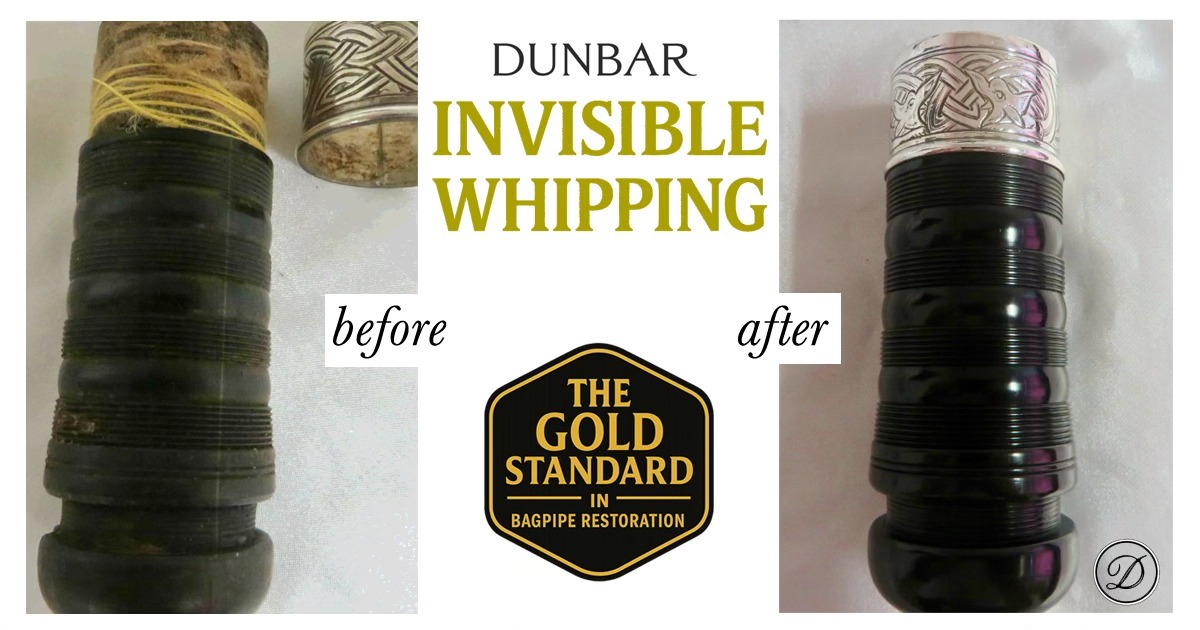Invisible Whipping: The Art of Holding It All Together
2025 Aug 13th
If you’ve ever handled a vintage set of pipes — whether a storied Henderson, a weathered MacDougall, or a faithful old Lawrie — you may have noticed it: a hairline crack creeping along the blowpipe stock, or a tenon starting to flake apart.
Even the best-seasoned ebony or cocuswood isn’t immune to time, moisture, and pressure. And when cracks appear in these high-stress joints, one of the oldest — and most effective — remedies is invisible whipping.
What Is Invisible Whipping?
First, no — it’s not unresolved emotional baggage from the Open Jig at Winter Storm. And it’s not the visible hemp wrapping you might use to adjust a tenon.
In general, whipping means tightly winding thread around an object to reinforce it. Invisible whipping is applying that technique so the repair is strong, but virtually undetectable. It’s most often used internally or beneath the surface to rescue cracks or splits in stocks and tenons without altering the outward look of the instrument.
The process typically involves:
1. Stabilizing or gluing the crack.
2. Precisely wrapping high-tension synthetic or natural thread around the area.
3. Recessing the whipping into a pre-cut channel or under a thin lathe-cut sleeve.
4. Sealing it with glue or epoxy.
5. Finishing and polishing until the repair blends seamlessly with the surrounding wood.
Done properly, invisible whipping can make a compromised joint stronger than it was when new.
Why It’s a Gold Standard in Bagpipe Restoration
* Structural Integrity – Repairs pressure-bearing areas like blowpipe stocks or bass mid-joints, acting like an internal cast without changing the instrument’s dimensions.
* Preserves Aesthetics – No visible bands or unsightly ferrule swaps; the historic look remains intact.
* No Acoustic Impact – Properly executed, it won’t change the resonance or tone.
* Long-Term Reliability – When done by an expert like Rick Pettigrew of Dunbar Bagpipes, who understands wood grain, glue behaviour, and bore tolerances, it’s a lifetime fix.
Why You Shouldn’t DIY Invisible Whipping
This is not a weekend project. Done wrong, invisible whipping can:
* Cut deeper into the wood, worsening damage.
* Distort the bore with over-tensioning, affecting tuning.
* Fail over time if the wrong glue or thread is used.
* Make future repairs harder if epoxy seals in undiagnosed damage.
When Invisible Whipping Might Be Needed
Cracks in Pressure Points – Especially those that flex under use or reopen after gluing.
* Loose or Spongy Joints – A flexing or wobbling tenon may be failing internally.
* Air Leaks Despite Good Hemping – Could signal a hidden split in the wood.
* Failed Past Repairs – Glue-only fixes that don’t hold, or visible wraps that compromise aesthetics.
* Antique or Heirloom Pipes – Older or thin-walled sets are more prone to stress cracks, especially at the blowpipe stock and drone tenons.

The Craftsman’s Touch
Invisible whipping isn’t just about fixing wood — it’s about preserving history, tone, and playability. It takes the eye of a restorer who understands both the mechanical and musical demands on a bagpipe.
At Dunbar Bagpipes, master craftsman Rick Pettigrew applies this repair with a surgical precision that’s been trusted by collectors, competitive soloists, and pipe bands around the world.
Think Your Pipes Might Need Invisible Whipping?
If your pipes creak, flex, leak, or show visible cracks — but you want to keep their original look and sound — invisible whipping may be the smartest move you’ll never see.
Contact Contact Master Craftsman Rick Pettigrew today to arrange an assessment.
